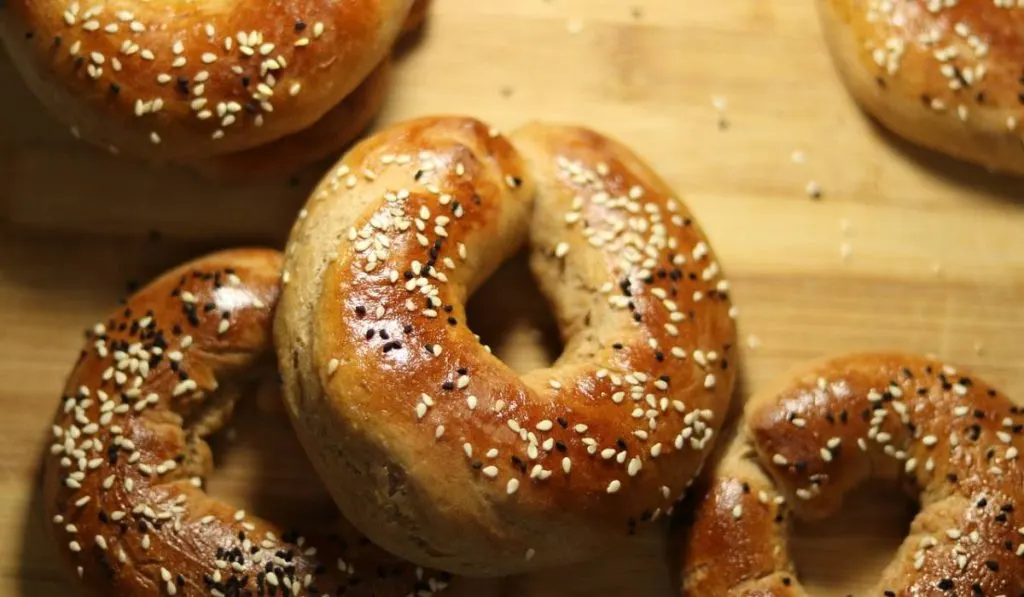
Ever find yourself with sourdough discard and wonder what to do with it? You’re not alone. Many baking enthusiasts face the dilemma of waste versus creativity. But what if I told you that your sourdough discard could become the star of your breakfast table? Let’s dive into the world of sourdough discard bagels, where waste meets gourmet delight.
TL;DR
- Transform sourdough discard into delectable bagels with a unique tang.
- Learn about the benefits of using sourdough discard for better taste and digestion.
- Get insider tips on achieving the perfect chewy texture.
- Explore creative flavor combinations and toppings.
- Discover how making bagels can be a fun family activity.
The Art of Turning Discard into Delight
Typically seen as just a byproduct of sourdough baking, discard is often overlooked. Yet, this underutilized ingredient holds the key to transforming everyday baking recipes into extraordinary culinary delights. When it comes to bagels, using sourdough discard can introduce a depth of flavor and a textural complexity that commercial yeasts simply cannot replicate.
What Makes Sourdough Discard Special?
Rich in wild yeasts and beneficial lactic acid bacteria, sourdough discard adds more than just flavor—it introduces a host of probiotics that aid in digestion. These microbes have already begun the fermentation process, breaking down the starches and gluten in the flour, which not only enhances flavor but also makes the nutrients more bioavailable.
The Science Behind Flavor Enhancement
The lactic acid bacteria in sourdough discard produce organic acids during fermentation, infusing the bagels with a slight tang that balances the inherent sweetness of the wheat. This tangy flavor profile is what makes sourdough bagels distinct, marrying well with both sweet and savory toppings.
Reducing Kitchen Waste with Sourdough Discard
Using sourdough discard in your bagel recipes is an excellent strategy for reducing kitchen waste. Instead of throwing away excess starter, repurpose it into your baking routine, contributing to a more sustainable kitchen practice without compromising on taste or quality.
Enhanced Flavor and Texture in Every Bite
The natural fermentation process of sourdough discard not only enhances the flavor but also alters the gluten structure, resulting in a chewier, more satisfying texture. This makes for a denser, heartier bagel, characteristic of traditional New York-style bagels but with an artisanal twist.
Improved Digestibility Through Fermentation
The fermentation process initiated by the yeasts and bacteria in sourdough discard helps to break down gluten, a common irritant for many people. This partial breakdown results in a product that’s easier on the stomach, making sourdough discard bagels a preferable option for those with mild gluten sensitivities.
Crafting Perfect Sourdough Discard Bagels
The journey from starter discard to delicious bagels involves mastering a few key techniques that ensure the perfect balance of flavor and texture. By understanding the unique properties of sourdough discard and how it interacts with other ingredients, you can create bagels that are not only delicious but also healthier and more digestible.
Mastering the Perfect Sourdough Discard Bagel
Making bagels with sourdough discard might seem daunting at first, but it’s surprisingly manageable once you understand the nuances of the boil and bake process. This technique is crucial for achieving the signature chewy texture and shiny crust that bagel aficionados love. Follow these detailed steps and tips to ensure your sourdough discard bagels turn out perfectly every time.
Detailed Ingredients and Preparation Guide
Begin by gathering your ingredients:
- Sourdough Discard: The star of the recipe, providing a unique tang and depth of flavor.
- High-Gluten Flour: Essential for developing the chewy texture that bagels are known for.
- Sugar: Just a touch to feed the yeast and enhance browning.
- Salt: To balance the flavors and strengthen the gluten network.
- Toppings: Choose from sesame seeds, poppy seeds, onion flakes, or coarse salt for finishing touches.
Preparation involves mixing the discard with the flour, sugar, and salt, then kneading the dough until smooth and elastic. Allow the dough to rest and rise until it doubles in size, which can take anywhere from 1 to 2 hours depending on the activity of your discard and the temperature of your environment. This resting period is critical as it allows the gluten to develop and the flavors to mature.
Shaping Your Bagels
Once your dough has risen, divide it into equal portions. Shape each portion into a round ball, then press a hole through the center with your thumb and stretch it slightly to form a traditional bagel shape. Let the shaped bagels rest for an additional 20 minutes; this relaxation helps the gluten structure and ensures they hold their shape during boiling.
The Boiling Secrets
Boiling is what sets bagels apart from other breads. Prepare a large pot of water and add a tablespoon of baking soda or malt syrup. These ingredients help create a more alkaline environment, which contributes to the bagels’ distinctive glossy crust and enhances the Maillard reaction for that golden-brown color.
Boil each bagel for about 30 seconds per side, ensuring they float to the top and puff slightly. This brief boiling not only forms the crust but also gelatinizes the starch on the surface, which contributes to their unique chewy texture.
Baking to Perfection
After boiling, place the bagels on a baking sheet lined with parchment paper, sprinkle with your chosen toppings, and bake in a preheated oven at 425°F (220°C) for 20-25 minutes. The high heat is crucial for achieving a crisp exterior while keeping the inside soft and chewy.
By following these steps, you’ll create sourdough discard bagels that are not only delicious but also boast a professional bakery-quality texture and appearance. Enjoy them fresh with cream cheese, smoked salmon, or your favorite bagel toppings for a delightful breakfast or snack!

Innovative Flavors and Toppings
While traditional bagels are fantastic, adding unique flavors can elevate your creations. Consider incorporating ingredients like cinnamon raisin, blueberry, or even savory options like garlic and onion into your dough. The possibilities are endless!
Family Fun with Bagel Making
Involve your family in the bagel-making process. It’s not only fun but also educational, teaching kids about fermentation and baking. Plus, everyone gets to customize their bagel!
1. Classic Plain Sourdough Discard Bagels
Ingredients:
- 1 cup sourdough discard
- 3½ cups high-gluten flour
- 1 tablespoon sugar
- 1½ teaspoons salt
- 1 teaspoon yeast (optional, for a quicker rise)
- 1¼ cups warm water
- 1 tablespoon baking soda (for boiling)
Preparation:
- Mix Ingredients: In a large bowl, combine the sourdough discard, flour, sugar, salt, and yeast. Gradually add warm water to form a stiff dough.
- Knead: Turn out onto a floured surface and knead for about 10 minutes, or until smooth and elastic.
- First Rise: Place the dough in a lightly oiled bowl, cover, and let rise until doubled, about 1-2 hours.
- Shape Bagels: Punch down the dough and divide it into 8 pieces. Shape each piece into a ball, press a hole in the center with your thumb, and stretch it out slightly.
- Second Rise: Place shaped bagels on a parchment-lined baking sheet, cover lightly, and let rest for 20 minutes.
- Boil: Bring a large pot of water to a boil and add baking soda. Boil each bagel for 30 seconds per side.
- Bake: Preheat your oven to 425°F (220°C). After boiling, place bagels back on the baking sheet, and bake for 20-25 minutes until golden brown.
2. Cinnamon Raisin Sourdough Discard Bagels
Ingredients:
- 1 cup sourdough discard
- 3½ cups high-gluten flour
- 2 tablespoons sugar
- 1½ teaspoons salt
- 1 cup raisins
- 2 teaspoons ground cinnamon
- 1¼ cups warm water
- 1 tablespoon baking soda (for boiling)
Preparation:
- Combine Dry Ingredients: In a bowl, mix the flour, sugar, salt, and cinnamon.
- Mix Dough: Add sourdough discard and warm water to the dry ingredients and mix until a dough forms. Fold in raisins.
- Knead and Rise: Knead the dough on a floured surface until smooth. Place in an oiled bowl, cover, and let rise until doubled.
- Shape and Rest: Divide the dough, shape into bagels, and allow to rest as per the classic recipe.
- Boil and Bake: Boil with baking soda, then bake at 425°F (220°C) for 20-25 minutes until they turn a deep golden brown.
3. Garlic and Herb Sourdough Discard Bagels
Ingredients:
- 1 cup sourdough discard
- 3½ cups high-gluten flour
- 1 tablespoon sugar
- 1½ teaspoons salt
- 2 tablespoons dried garlic flakes
- 2 tablespoons dried Italian herbs
- 1¼ cups warm water
- 1 tablespoon baking soda (for boiling)
Preparation:
- Prepare Dough: Mix flour, sugar, salt, garlic flakes, and herbs in a bowl. Add sourdough discard and water to form the dough.
- Knead and First Rise: Knead until smooth, then let rise in an oiled bowl covered until doubled.
- Shape Bagels: Follow the same shaping and resting instructions as the classic recipe.
- Boil: Add bagels to boiling water with baking soda for 30 seconds per side.
- Bake: Place on a baking sheet, bake at 425°F (220°C) for 20-25 minutes until crispy and golden.
Each recipe provides a unique flavor profile, from the sweetness of cinnamon raisin to the savory richness of garlic and herbs, expanding the versatility of sourdough discard in your baking repertoire. Enjoy crafting these delightful bagels!
Conclusion
Making sourdough discard bagels is more than just baking; it’s a journey into the heart of flavor innovation and sustainability. With each batch, you not only create delicious treats but also contribute to a more sustainable baking practice. Happy baking!
FAQs
What is sourdough discard?
Sourdough discard is the portion of sourdough starter that is removed and not fed during the refreshment process to keep it active and healthy.
Can I freeze sourdough discard bagels?
Yes, you can freeze them after baking. Just ensure they are cooled down and stored in airtight bags.
How long can I keep the sourdough discard before using it in recipes?
Sourdough discard can be kept in the refrigerator for up to a week or frozen for longer storage.
Can I use whole wheat flour for making sourdough discard bagels?
Yes, whole wheat flour can be used for a healthier option, though it may alter the texture slightly.
Do I need any special equipment to make bagels at home?
Basic kitchen tools like a large pot for boiling, a baking sheet, and parchment paper are sufficient for making bagels.
Join Us and Transform >
Don’t Be an Amateur! Master the Art of Sourdough Bread!




Leave a comment